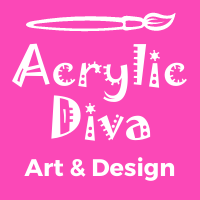Five Ways To Start An Abstract Painting
Red and Black Abstract - Created in Procreate by Tesia Blackburn
Looking to get started in abstract painting? Wondering how to begin? Check out these tips from a seasoned pro. I’ve been an abstract painter (both digital and traditional) for decades. Take it from me… having a plan helps, a lot! For more great tips, check out my book Acrylic Painting With Passion available in hardback and on Kindle.
Color exploration: Start by selecting a color palette that inspires you and experiment with layering and blending colors on the canvas. You can use a variety of tools such as brushes, palette knives, sponges, or your hands to apply the paint and create interesting textures. Check out this palette of SoFlat colors by Golden. Six colors that allow you to make a huge variety of tints, mutes, and shades. Add to that the fact that these have the most delicious matte surface, and you’ve got a winning set.
Gestural mark-making: Start by making loose, expressive marks on the canvas using charcoal, graphite, or paint. Allow your intuition and body movements to guide the process, focusing on the energy and rhythm of the marks rather than any specific representation. One of my favorite tools for mark making is a big chunky piece of graphite. These Lyra sticks are water-soluble so they work great with acrylic.
Collage: Start by creating a textured surface on the canvas using torn pieces of paper, fabric, or other materials. Once you have a base layer, you can start layering and blending paint to create an abstract composition that integrates the collaged elements. Use Golden Soft Gel Gloss to adhere collage elements to canvas. Compatible with acrylic paint, of course!
Experiment with different techniques: Try using unconventional tools or techniques to create marks on the canvas, such as pouring, splattering, dripping, or scraping paint. You can also experiment with different mediums such as watercolor, acrylic, or oil paints to create unique effects. I love the Catalyst Blades made by Princeton for scraping. They’re sturdy, clean easily and make a variety of marks.
Start with a concept or emotion: Begin by brainstorming a concept or emotion that you want to convey through your painting. This could be something abstract like love, joy, or loneliness, or something more concrete like a landscape or cityscape. Use the concept as a starting point to guide your color choices, composition, and mark-making. For instance, what color would you say love is? What texture do you associate with loneliness? What shape do you see when you think of the word joy?
These are just a few of the ways you can get started in abstract painting. One more tip - find an abstract artist you love and spend some time reinterpreting their work. You’ll learn a lot!

